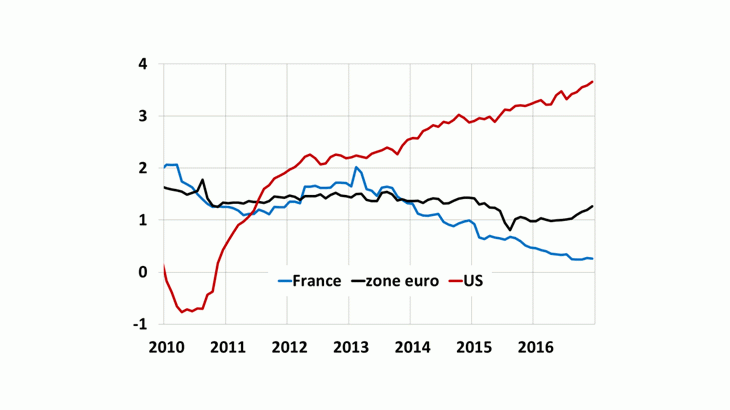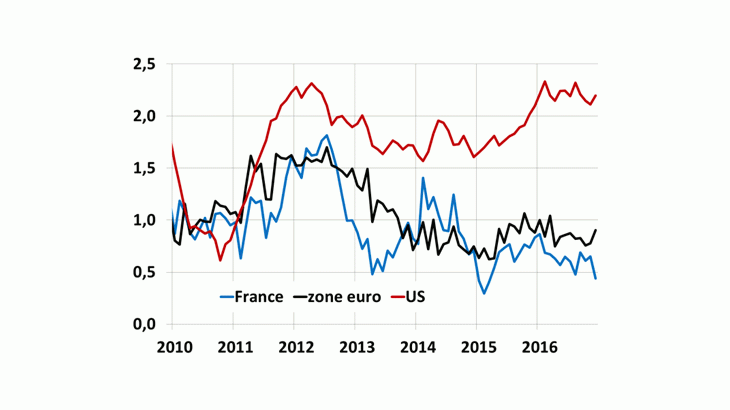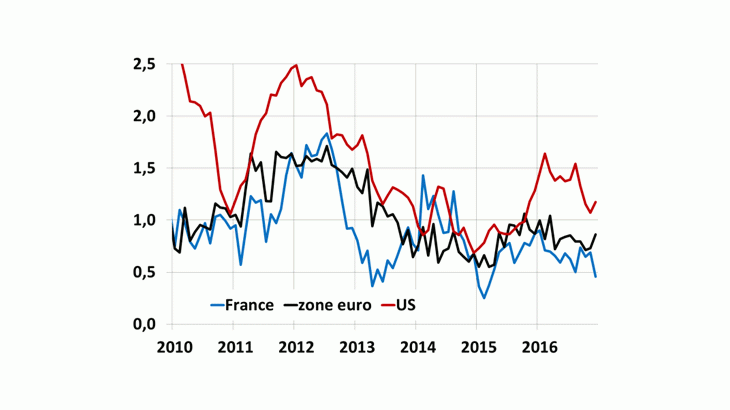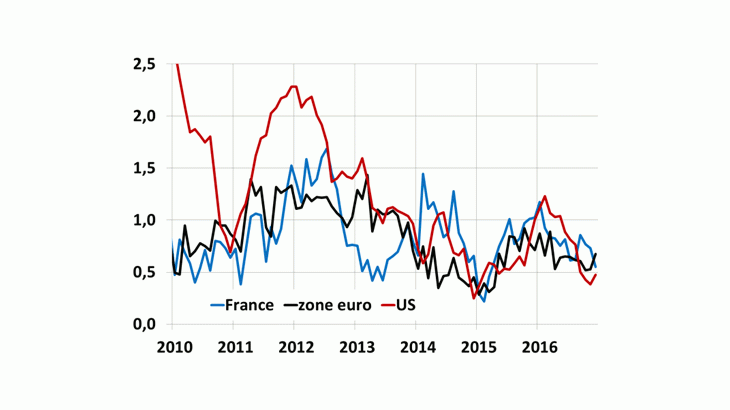Post n°5. Since 2012, the underlying inflation differential between the United States and the euro area has mainly been due to the vastly different role of rent in the two price indices. On average, this accounts for 70% of the differential, both in the euro area and in France. Property cycles must be taken into consideration when interpreting inflation differentials between countries.

The role of the increase in and share of rents in underlying inflation
In this transatlantic comparison, inflation is measured using the CPI (consumer price index) for the United States and the HICP (harmonised index of consumer prices) for the euro area (EA). This analysis focuses on what is referred to as "underlying" inflation, i.e. price inflation excluding energy and food. Energy and food prices are more volatile and, in the case of energy in particular, mainly determined by international factors. It is therefore better to exclude them when comparing the fundamental differences in inflation across countries.
Underlying inflation in the United States stood at 2.2% in December 2016, 1.3 percentage points higher than in the euro area and 1.8 percentage points higher than in France (all figures are on a year-on-year basis). A more detailed breakdown of the indices shows that
the difference between the countries is explained in large part by rent developments. This is due to two factors:
- Firstly, rents have increased far more quickly in the United States than in the euro area and France (see Chart 1); and
- Secondly, the share of rents in the price index is greater in the United States (40% of the underlying price index, compared with only 12% in the euro area and 10% in France). The US index, unlike the European index, includes owner equivalent rent, which accounts for two- thirds of the share of rents.
The greater share thus amplifies the effect of rent increases on the US price index.

Transatlantic similarities in underlying inflation excluding rents
To clarify the role of rents, let's look at the underlying inflation indices excluding rents for each of the economies under review. Underlying inflation in the United States would be significantly lower if rents were excluded from the price index (1.2% in December 2016 compared with 2.2% with rents) but would hardly change in France and the euro area (see Charts 2A and 2B). In total, three-quarters of the underlying inflation differential between the United States and France and more than half of the differential between the United States and the euro area in December 2016 is due to the contribution of rents. Since the end of 2012, almost 70% on average of the differential for both France and the euro area has thus resulted from the difference in rent developments.

A.Underlying inflation in the United States (BLS), France and the EA (Eurostat), year-on-year basis (%) EA and France (Eurostat), year-on-year basis (%)

The transatlantic inflation differential since 2012 is principally a result of the significant divergence between the US and European real estate markets. The US market posted a net recovery after a bubble of historic proportions (Grossmann-Wirth V., Rivaud S. and Sorbe S. (2011)), whereas on average, the European markets were hit by a crisis that was initially less violent but lasted longer, particularly in France (Sutter C., Faubert V. and Monnet (2015); Monnet and Thubin (2017)).
The specific role of healthcare costs in the United States in 2016
Chart 2B also shows that in 2016 rents no longer fully explained the inflation differential (the gap between the red curve and the black and blue curves widens). Indeed, the rise in underlying inflation in the United States since the end of 2015 was also caused by the contribution of healthcare costs. To illustrate this, we construct underlying inflation indices excluding housing and healthcare, which show that without these two components, underlying inflation in the United States would be 0.5% in December 2016 compared with 0.7% in the euro area and 0.6% in France (see Chart 3).

Nevertheless, healthcare inflation is not particularly robust to different measures, unlike rent inflation. Indeed, in the PCE (personal consumption expenditures) index, which is the US Federal Reserve's benchmark, the rise is significantly smaller (as the European equivalent of this index is less used, we focus on the CPI). This phenomenon, which is still recent and little documented, should therefore be assessed with caution.
The need to integrate the property cycle into inflation analysis.
This blog does not recommend using an index that excludes rents (nor an index excluding rents and healthcare costs): it would provide little information in itself as it only includes a very limited part of consumer goods and services. Nevertheless, this comparison shows that the majority of the domestic inflation rate differential between the United States and the euro area since 2012 can be explained by differences in rent developments and, more recently, healthcare.
While the economic recovery has indeed been at a more advanced stage in the United States than in the euro area since 2012, the faster growth in inflation on the other side of the Atlantic is primarily due to the recovery of its real estate market. Therefore, it is advisable to take account of the analysis of real estate markets together with the analysis of economic cycles in inflation comparisons. In addition, from a methodological point of view, it is important to continue examining the way in which the differences in the share of rents in the price indices between Europe and the United States can influence the observed inflation differential. Developments are underway to also integrate owner equivalent rent (i.e. an equivalent amount of rent that would be paid for a currently owned house) in the European price indices (see Box 4, p. 47, of the ECB Economic Bulletin, 2016, vol. 8).
Updated on the 25th of July 2024